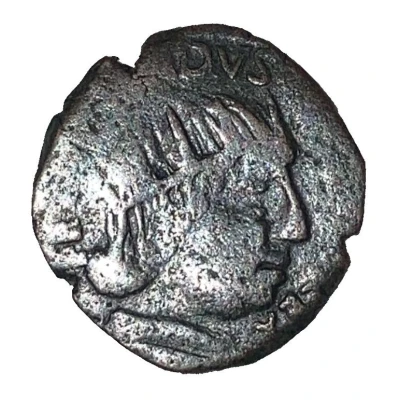


© igorstelli (CC BY-SA)
1 Cavallo - Ferdinando I ND
| Copper | 1.90 g | 18 mm |
| Issuer | Kingdom of Naples (Italian States) |
|---|---|
| King | Ferdinand I Ferrante (1458-1494) |
| Type | Standard circulation coin |
| Years | 1472-1486 |
| Value | 1 Cavallo (1⁄1440) |
| Currency | Piastra (1266-1812) |
| Composition | Copper |
| Weight | 1.90 g |
| Diameter | 18 mm |
| Thickness | 0.5 mm |
| Shape | Round (irregular) |
| Technique | Hammered |
| Orientation | Coin alignment ↑↓ |
| Demonetized | Yes |
| Updated | 2024-10-05 |
| Numista | N#346990 |
|---|---|
| Rarity index | 92% |
Reverse
Gradient horse to the right, left front leg up.
Text in exergue. Straight line above exergue stops before rim
Script: Latin
Lettering: °EQVITAS° °REGNI
Translation: Knights of the Kingdom
Edge
Plain
Comment
The tumultuous reign of Ferdinand I of Aragon (1458-1494) over Naples, which went down in history for its harshness and for all the threats it had to face, remains a "well of St. Patrick" as regards numismatic coinage. Wanting to summarize the coinage of Ferdinand I of Aragon let's say immediately that the coinage was, as usual for the period, in gold, silver and copper alloy. Double ducats were minted in gold, ducats plus a 1.5 ducati medal coin known in a single specimen and minted - probably - for Ferdinand's entry into Naples on 17 December 1486; then we have the silver coins (tarì, coronati, carlini, half carlini and quarters of carlino), the mixtures (tornesi and denari) and finally the copper (cavalli).Focusing on the latter type, it must be said that, for the first time, the horse was minted on 18 April 1472 to replace denarii and tournoises which presented two major problems: the former were ill-accepted by the people due to the scarce amount of silver contained, the seconds for the numerous presence of counterfeits of tournaments and denarii.
The pure copper horse was therefore a bad deal for counterfeiters, as its value was very little higher than the metal used. As far as horses are concerned, we know a large number of mintings for both the Naples mint and the L'Aquila mint. To differentiate the horses of Ferdinand I we must divide them into two groups: 1st group or period, D/ FERDINANDVS REX (crowned head of the sovereign on the right) and R/ EQVITAS REGNI (gradient horse on the right),
and 2nd group or period, Obv/ FERRANDVS REX (crowned head of sovereign right) and R/ EQVITAS REGNI (gradient horse right).
This difference marks a historical passage in the reign of Ferdinand I as the legend is changed after the revolt of L'Aquila against the sovereign. We therefore know that the FERDINANDVS REX horses are minted from 1472 to 1486, while those with FERRANDVS belong to the 2nd period ending in 1494.
Vittorio Emanuele III in the Corpus Nummorum Italicorum already numbers 214 variants divided into 9 subtypes as regards L'Aquila and 261 variants for the mint of Naples while the catalog Monete Italiane Regionali greatly narrows the field by listing four types of horses divided into subcategories for Naples and seven types of horse divided between 1st and 2nd period or group in the reign of Ferdinand I.
Finally, in 2009, Simonluca Perfetto recatalogated all the coinage and legend variants, including what was already known and adding the results of new and in-depth research in the full-bodied volume La Zecca dell'Aquila censendo, only for the 2nd period of Ferdinando I , as many as 166 legend variants.
Some more examples pictured below:
Interesting fact
One interesting fact about the 1 Cavallo coin from the Kingdom of Naples is that it features an image of King Ferdinand I on horseback, which symbolizes his power and leadership.



